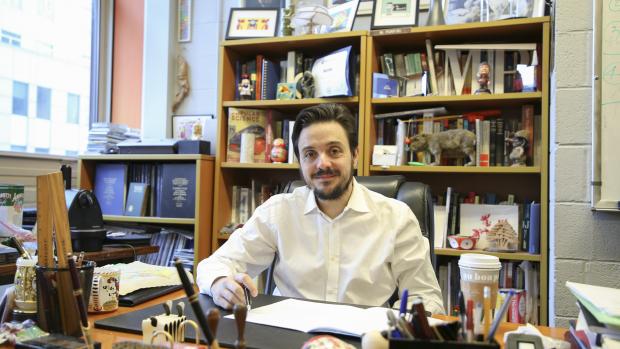Complex environments pose complex challenges, but the new director of CUSP thrives on complexity
Institute Professor Maurizio Porfiri to lead Center for Urban Science and Progress

How do animals behave? How do people reach a consensus? How does a pandemic spread? What drives gun purchases? What happens when particles collide? Can a deep sea sponge hold the answer to stronger skyscraper design?
On the surface, those questions appear to have little in common, but Maurizio Porfiri sees a clear connective thread — dynamic, complex systems whose key to understanding lies in leveraging a distinctive combination of data science, physics principles, and other aspects of engineering. Porfiri’s research space at Tandon is called the Dynamical Systems Laboratory precisely because of his fascination with the unseen relationships in data sets both big and small that reveal how complex systems work. And as an Institute Professor with appointments in the Departments of Mechanical & Aerospace Engineering, Biomedical Engineering, and Civil & Urban Engineering, he’s able to draw on an uncommonly diverse set of expertise to shine a light on previously undetected patterns that can help model outcomes for extremely difficult scenarios.
Now, he is taking that expertise and a unique vision for the potential of urban science to lead the Center for Urban Science and Progress (CUSP) as its new Director.
CUSP had its genesis in 2012, when New York City issued a call for a new kind of academic center that would ensure that the city remains a world capital of applied sciences and technology, dramatically grow its economy, and function in collaboration with nonprofits, the public, and the city itself.
Since its inception, CUSP has grown to become a thriving research hub that uses New York City and other urban areas as living labs to develop novel data- and technology-driven ways to improve city services; optimize decision-making by local governments; create smart urban infrastructures; and address challenging issues such as crime, environmental pollution, and public health. The Center has been celebrated for major projects that make urban communities safer, healthier, and more livable, including SONYC, an initiative to measure and mitigate noise pollution–a top-ranked quality-of-life concern for all New Yorkers; FloodNet, which in collaboration with C2Smart, Tandon’s US DOT Tier 1 transportation center, seeks to monitor and predict local flooding; and WE-SAFE, an interdisciplinary project to understand and engineer the firearm ecosystem in the U.S.

And — with the help of a large group of faculty members whose expertise encompasses AI, assistive technologies, data science, environmental science, human-technology interaction, public health, robotics, and numerous other fields — Porfiri foresees CUSP moving in an even more expansive direction.
Porfiri’s unique expertise in complex systems makes him well-suited to lead a research center at the forefront of defining what a post-pandemic, modern city can — and should — look like. It’s an especially pressing issue since for the first time in history more than half of the world’s population lives in urban areas; in just a few more decades, that figure will increase to 70 percent. Enabling those cities to deliver services effectively, efficiently, and sustainably while keeping their citizens safe, healthy, prosperous, and well-informed will be among the most important undertakings of this century.
Building upon the work of previous directors, Porfiri plans to hone in on three key application areas: urban environment, urban health, and urban infrastructure — each a cornerstone of equitable, liveable, and sustainable cities. Solving real-world problems in any of these application areas demands fundamental research in a trio of core methodical foundations, which define the full research cycle in urban science, from data collection (sensing) to data analysis (informatics) to the modeling, design, and diagnostics of complex urban systems (complexity).
Working toward the vision of a research center that builds bridges between departments in the School of Engineering, various schools of NYU, and the university and the world’s metropolitan areas, he plans to create
- A research partnership program for public and private organizations that will be invited to engage in informing CUSP’s research agenda, participate in the life cycle of collaborative grants and projects, and access a pool of exceptionally qualified potential employees
- An Urban Science Colloquium to engage the overall NYU community in urban science and learn from community stakeholders about their needs, values, and desires as NYC residents
- A series of CUSP-led discussion groups on critical urban issues for the general public in partnership with student associations at the School of Engineering: the first planned series, Engineering Safer Cities, will focus on deconstructing violence, criminality, and neighborhood security.
- An interdisciplinary track in urban science for Ph.D. students at the School of Engineering — paving the way for the first cohort of doctoral-level urban scientists in the history of the school.
That last initiative will allow Ph.D. students to leverage their specific expertise to address urban processes. A biomedical engineer, for example, might choose to explore how more accessible infrastructure can improve the lives of those with mobility challenges, or an electrical engineer could aim to bridge the digital divide by focusing on expanding internet access to underserved communities.
"Cities have social, technical, and environmental components," Porfiri asserts, "and engineers like those we’re educating at CUSP address the important intersections between them. We want them to be at the leading edge of contributing to fundamental urban science while providing timely, practical, and actionable insights.”





